
Sourse: Own elaboration
Organizational Culture, Identity and Image. A Case Study Conducted in an Argentinian Public University1
(*) Pujol-Cols, Lucas; (**) Foutel, Mariana; (***)Barbisán, Romina
(*)CONICET.
Mar del Plata, Buenos Aires, Argentina
lucaspujolcols@gmail.com
(**) Universidad Nacional de Mar del Plata
Mar del Plata, Buenos Aires, Argentina
marianafoutel@yahoo.com.ar
(***)Universidad Nacional de Mar del Plata
Mar del Plata, Buenos Aires, Argentina
romina_barbisan@hotmail.com
Reception Date: 03/30/17 – Approval Date: 06/27/2017
SUMMARY
The study and understanding of organizational culture assumes a central role for university management, as it becomes a strong conditioning factor during decision-making at all levels. By providing members with a socially shared and unconscious frame of reference that guides them in their way of perceiving, interpreting and reacting to the events that take place in the organization, it also strongly influences the individual, group and organizational rationality that underlie the decision process. But in order to avoid excessively simplifying analyzes, the organizational culture needs to be studied in its interaction with the identity and the organizational image. The main purpose of this research is the construction of a diagnosis of the culture, identity and organizational image of a Faculty belonging to an Argentine Public University. For this, a case study methodology is used, based on the triangulation of quantitative sources (by administering questionnaires to 63 teachers and 9 support staff members) and qualitative (through the conduction of 2 focus groups with teachers and 1 with support staff members).
KEY WORDS: Organizational Culture; Organizational Identity; Organizational Image; Case study; Higher education.
INTRODUCTION
Since the mid-twentieth century, much has been discussed about the concept of organizational culture and the implications that its adequate understanding has for the achievement of effective management. Even, and as Giorgi, Lockwood and Glynn (2016) point out, there has been a notable resurgence of interest in the subject in recent years. However, even when certain advances have been achieved from the conceptual and theoretical levels, appreciable difficulties are still evident when it comes to achieving adequate operationalization that allows for an empirical approach. Sackmann (1992) warns that part of such obstacles come from the notorious ambiguity inherent to the phenomenon, the deep conceptual fragmentation present in the field and the almost exclusive concentration of researchers in the most tangible aspects of the organizational culture, such as the physical elements , practices, procedures and standards. A similar situation occurs with the study of the two remaining constructs that are the focus of this article, the identity and the organizational image, which are not exempt from the previously mentioned ambiguities.
The study and understanding of the organizational culture assumes a central role for university management by configuring itself as a strong conditioning factor for decision-making at all levels. By providing members with a socially shared and unconscious frame of reference that guides them in their way of perceiving, interpreting and reacting to the events that occur in the organization (Schein, 1984), it also strongly influences individual, group and social rationality, organizational that underlies when thinking about alternatives and their restrictions (what is possible); proceed to its evaluation (the best); define which aspects should be prioritized (what is desirable) and which should be avoided (the prohibited); consider which actors should be part of the process; etc. However, it agrees with Hatch and Schultz (1997) that the organizational culture needs to be studied in its interaction with the identity and the organizational image, as these phenomena constitute three interrelated parts of the same system of construction of meaning that defines the organization in its most constitutive elements (Hatch and Schultz, 2002). More static models of organizational culture (e.g. Schein, 1984) are insufficient to account for the processes involved between these three constructs, which is why, in this article, we will seek to make this vision more complex using the so-called cultural dynamics model (Hatch, 1993; Hatch and Schultz, 1997).
The main purpose of this work is to prepare a diagnosis of the identity, culture and organizational image of a university institution, based on the discourse of its employees (both teachers and support staff), from a mixed approach. For this, the reader is offered a structure composed of two large sections. In the first, called -Development-: (a) the main theoretical propositions that have been taken into account both for the construction of the collection instruments and for the interpretation of the results obtained are described; and (b) the main findings of this research are reported and discussed. In the second, entitled -Conclusion-, the main contributions of this study are summarized.
DEVELOPMENT
Conceptual framework
The concepts of culture, identity and organizational image constitute three interrelated parts of the same integrated system of meaning construction that defines the organization in its most constitutive elements (Hatch and Schultz, 1997). As pointed out by Hatch and Schultz (2002), the deep underlying interrelationship between these three phenomena forces researchers to study them comprehensively, in order to be able to account for the complex processes involved between them.
Schein (1984, p.3) understands organizational culture as the pattern of basic presumptions that a certain group has created, discovered or developed when trying to respond to problems of both external adaptation and internal integration, which has proven to work sufficiently well as to be considered valid and, therefore, be taught to new members as the correct way to perceive, think and feel in relation to such problems. Focusing on its core components, Deal and Kennedy (1982) point out that the most relevant elements to analyze it are the values, the heroes, the rites and rituals, the cultural network and the environment in which it has emerged, has developed and operates currently the organization.
According to the model of Schein (1984), the culture of an organization exists on three levels, each exhibiting a different degree of superficiality and visibility. In the first place are the artifacts, the most visible and tangible elements of culture. Among them it is possible to mention narrate the physical work space, technology, codes (formal or non-formal) of clothing, observable patterns of behavior, stories, etc. Second, there are the values that usually govern human behavior within the organization. That is, while artifacts respond to -what happens-, this second element aims to respond to -why-. However, it is common for individuals to behave in a certain way for reasons that they themselves do not know and that probably have never been questioned. This unconscious reproduction of behaviors obeys what Schein (1984) has called underlying basic presumptions, constituting the hardest core of the organizational culture and, ultimately, its own essence.
The scientific study of organizational culture can be done from different levels of knowledge analysis. The most usual of them is to study it at the level of groups or of the organization as a whole. But by constituting a framework for the construction of meaning, it can also be approached at the individual level. From this last level of analysis, Harris (1994), studies the influence of organizational culture on the processes and structures of sensemaking (Weick, 1993)2. In this sense, it is represented as a system of schemes that act as mental maps or frames of reference that guide perception, memory and inference and guide the subsequent behavior of the subjects (Markus, 1977). These schemes function as a repository of cultural knowledge from which individuals are used to make sense of the events that occur in organizational life (Sackmann, 1992). It is constituted by values and beliefs attributed to individuals and collectivities, behaviors defined as appropriate to various situations, traditional ways of doing things, normative or group pressures, role knowledge, the meaning attributed to physical, verbal and other artifacts behavioral, and the distinctive characteristics of the organization and its subgroups.
Since the organizational culture represents a collective phenomenon, this is reflected in the emergence of relatively congruent schemes between the members of an organization, whose content has a similar salience, and which mold and are shaped by sense making processes (Harris, 1994). A measure that the individual schemes become more similar, the information that they provide to the subjects tend to become more focused, rigid, clear, consistent and persuasive. In coincidence with Schein (1985), Ribes Pons (1997) emphasizes that it is interesting to know the degrees of coherence and consistency that a certain organizational culture presents. Consistency analyzes allow knowing the internal contradictions and knowing to what extent the cultural variables of an organization are assumed and shared by its members.
The second of the constructs involved, the organizational identity represents a collective and commonly shared understanding of the most central, enduring and distinctive attributes of an organization (Albert and Whetten, 1985). It refers to what its members perceive, feel and think about it and its salient aspects (Hatch and Schultz, 1997). For these authors, organizational identity emerges from a deeply self-reflective process oriented to answer two questions: who are we as an organization? and why do we exist?
Unlike the organizational culture, it is an eminently relational concept (Gioia, 1998) that is constructed as a result of the interplay between two complementary processes. On the one hand, managers make formal statements (formal claims) with the intention of shaping members' interpretations (sense giving). But, at the same time, internal agents negotiate shared meanings about what the organization is and what its most distinctive elements are (sense making).
Contrary to what is usually maintained in the literature, Gioia, Schultz and Corley (2000) question the alleged stability of organizational identity arguing that it has been camouflaged in a relative invariance of the labels used by members of an organization to express what they believe the organization is, but that its associated meaning tends to change over time. The authors propose organizational identity as a mutable and dynamic phenomenon that is subject to revisions and renegotiations.
Finally, the third element of this conceptual triad, the organizational image, refers to the way in which the members of an organization believe that it is seen by other external agents (Dutton and Dukerich, 1991). This internal perspective of the organizational image (what others think) is constructed as a result of the daily interaction between internal and external agents as well as the deliberate attempts of managers to influence public opinion. Gioia et al. (2000) point out that while organizational identity responds to the question of who are we as an organization? the organizational image responds to who do they think we are?
Method
1. Description of the study context
This study was conducted in the Faculty of Economic and Social Sciences, which is one of the nine faculties that together make up the National University of Mar del Plata (Argentina), of financing and state management. This faculty currently dictates five undergraduate degrees (Public Accountant, Bachelor of Administration, Bachelor of Economics, Bachelor of Tourism and University Teaching in Economics) and four non-doctoral postgraduate majors.
2. Design and objectives
The present research constitutes a case study (Yin, 2002, Eisenhardt, 1989), based on the triangulation of quantitative and qualitative primary data, as well as secondary information collected through a review of documentary sources (Patton, 2002). The purpose of this work is to prepare a diagnosis of identity, culture and organizational image of the Faculty of Economic and Social Sciences of the National University of Mar del Plata from the discourse of its employees, including both teachers as to the support staff 3, from a mixed approach4.
3. Techniques and procedure
Schein (1995) points out that the organizational culture should be observed instead of measured, in the sense that it is composed of a set of underlying, almost invisible, elements that define shared, tacit and taken for granted forms of perceiving, feeling and react (Schein, 1984). To this end, he recommends clinical or ethnographic methods, highlighting the need for the researcher to be sufficiently immersed in the organizational reality under observation. In the same line is the approach of Hatch and Schultz (1997, p.357) when they warn that culture should not be seen by the researcher as a -variable to be measured- but should be studied as part of an integrated system in close connection with the identity and the organizational image.
In a way that coincides with the dominant paradigm in the scientific community, this research was based predominantly on qualitative data, which were surveyed in two stages. In the first, two focal dynamics (focus groups)5 were carried out by each group of university workers (teachers and support staff), each with an average duration of 60 minutes. In the second one, an adaptation of the Questionnaire of Culture, Identity and Organizational Image developed by Pujol Cols and Foutel (in evaluation) to a non-probabilistic sample composed of 63 teachers and 9 support staff members6.
The results of the focus groups served methodologically four purposes: (a) to increase the degree of immersion of the researchers in the object of study; (b) identify the potential axes of inquiry of the survey questionnaire; (c) construct the answer categories of the closed questions of the survey questionnaire; (d) provide a contextual framework for the interpretation of quantitative data that facilitates researchers to make conclusions that rise from the level of individual analysis to the group and organizational levels.
Each dynamic was attended by a moderator and an assistant. In all cases, the role of the moderator was limited to: (a) suggesting shooting themes contained in the script, (b) provide clarification to specific requirements of the participants, (c) request that participants broaden their discourse or deepen in a given topic, (d) redirect the dynamics when it escapes from the objectives of the study.
The adaptation to the Identity, Culture and Organizational Image Questionnaire maintained its semi-structured design by including both closed questions (useful to identify trends in the behavior of certain variables, explore differences between social subgroups, obtain synthesis indicators and achieve generalizations attributable to the population set) as open questions (to enable the emergence of unintended elements and obtain evidence that can be triangulated with that obtained through the focus groups).
4. Participants
A total of two focus groups were held with teachers and one with support staff members, with 11 and 9 individuals participating in the first group and 8 in the second. In the conformation of each one, we tried to achieve heterogeneity of profiles, establishing a set of segmentation criteria ex ante. These were: (a) Teachers: dedication (low and high dedication), position hierarchy (Professor, Assistant) and performance area (Administration, Economics, Tourism, Accounting, Social Sciences, Mathematics and Law); (b) Support Personnel: seniority, grouping and category. In order to avoid conditionality in the responses, none of the dynamics included members with involvement in the School Management. The data referring to the composition of each focus group are presented in Tables 1, 2 and 3.
In a second instance, 63 surveys were carried out for teachers and 9 for support staff. The segmentation criteria used to endow the sample with representativeness coincide with those used for the focus groups. The sample of teachers was formed by 47.61% of Professors and 52.39% of Assistanties. 74.60% of the teachers interviewed have a regular position, 20.63% an interim position and 4.77% an attached position (unpaid). In relation to the dedication, the sample was composed by 74.60% of teachers with simple dedications, 4.67% with partial dedications and 20.63% with exclusive dedications. Finally, 34.93% of the teachers surveyed belong to the Administration Department, 31.75% to the Accounting Department, 14.29% to the Economy Department, 9.52% to the Tourism Department, 4.76% to the of Social Sciences, and 4.76% to Mathematics. Regarding the support staff, the sample consisted of 88.89% of administrative employees and 11.11% of technical support employees. 11.11% have a category 3, 33.33% have a category 4, 22.22% have a category 5 and 33.33% have a category 7.
Table N° 1: Participants of Focus Group with professors . Dinamic 1

Sourse: Own elaboration
Table N° 2: Participants of Focus Group with professors. Dinámica 2

Sourse: Own elaboration
Table N° 3: Participants of Focus Group with personnel help
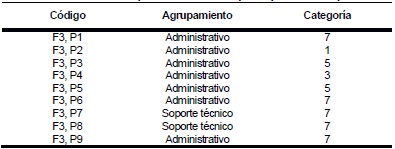
Sourse: Own elaboration
Results and Discussion
1. Organizational Identity
The construction of organizational identity emerges from a deeply self-reflective process oriented to respond to: who are we as an organization?, why do we exist? and how do we differentiate ourselves from the rest? Regarding the first two questions, in the focus groups the participants of the three groups quickly agreed that it is a faculty dedicated to providing technical education in the disciplines of Administration, Accounting, Tourism and Economics. The two additional functions to the teaching activity, research and knowledge transfer to the community, emerged predominantly in the dynamics carried out with teachers and to a lesser extent in those of support staff.
First, both in the focus groups and in the questionnaires, the participants were asked to list a set of main features of the Faculty. Here two fundamental factors were analyzed: the salience (frequency of evocation, number of times the attribute is mentioned by the participants) and centrality (place occupied by the attribute in the mind of the subject, order of mention). When qualifying the degree of salience (high, moderate or low) of certain elements, the evidence collected was triangulated through both the focus groups and question 4 of the surveys, as follows: (a) high salience: the element is mentioned in all the groups; (b) moderate salience: the element is mentioned in only one of the groups but emerges with some reiteration in the questionnaires; (c) low salience: the element is mentioned in only one of the groups and emerges with sporadic reiteration in the questionnaires. When qualifying the degree of centrality (high, moderate or low), the information of the mentions corresponding to question 4 of the surveys was used, as follows: (a) high centrality: the element emerges at first mention; (b) moderate centrality: the element emerges at second mention; (c) low centrality: the element emerges in third or subsequent references. The results are presented in Table 4
Table N° 4: Salience Satisfaction degree and number of main paticipants featuresde
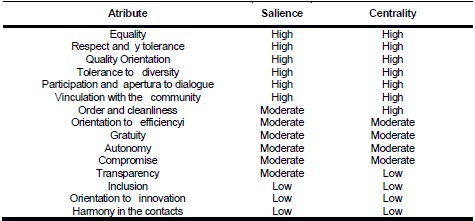
Sourse: Own elaboration
From Table 4, it can be deduced that equality, respect, orientation to quality, tolerance to diversity, participation and openness to dialogue, linkage with community and order, seem to be, from the perception of these participants, the most characteristic features of the Faculty. With regard to the attributes -autonomy-, -gratuity-, -commitment- and -inclusion-, it is worth highlighting that although they registered low and moderate levels of salience and centrality in the surveys, being mentioned mostly by the teachers, the same they emerged with a high level of consensus in the focus groups for the two groups of participants.
Regarding the attribute -inclusion-, the focus groups inquired into what the participants understood by an inclusive university, emerging other associated concepts such as "democracy" and "popularity": "the popularity ... is not an elitist university" ( F1, P4), "I believe that it is not an elitist university but neither is it a popular university ... if we associate popular with the lower-middle class ... today the composition of the students is of the middle, upper-middle and upper classes" (F2, P7).
Regarding the commitment, it was observed that several participants agreed that it does not only characterize the faculty member of that faculty ("I believe that class is given not because of being against (strikes) class is given for the commitment to comply with the agenda "; F1, P3) but also to the support staff (" you enter this Faculty and everything is impeccable, it works like a little clock "; F2, P4).
Once spontaneous evidence was gathered, in question 5 of the questionnaire, each participant was given a list of attributes and was asked to indicate, from their perception, the degree of presence of each of them in the Faculty, giving a score of 1 (less presence) to 5 (greater presence). It was observed that one of the elements presented in Table 4, and even if it had been classified as highly salient and central, registered a low average score (see Tables 5 and 6), both for teachers (arithmetic mean = 3). , 49, standard error = 1.03) as the support personnel (arithmetic mean = 3.44, standard error = 0.88). This is the case of quality orientation.
The divergences observed in relation to this attribute could be explained by the fact that, although quality represents a desirable trait for any university organization, participants could perceive that it is threatened. In effect, contextual forces put pressure on the University to adopt, little by little, a more flexible and accommodating behavior in its relationship with students, which has materialized in concrete decisions, such as the reduction of approval requirements ("a lot of facilitation"; F1, P7), the increase in the number of evaluation instances ("there are multiple instances of approval", F2, P1) and the elimination of restrictive admission modalities ("an unrestricted entry was made without an adequate course that is really Equalizer of opportunities for those who do not have the adequate previous training to face successfully the university studies ", F2, P5). From the point of view of the participants, this has had an impact on the quality of education and, consequently, has come into collision with an organizationally desirable principle. In the focus groups, a high level of consensus is shown in which the quality of the educational system in general has deteriorated markedly, reaching impact on the university system and, punctually, also in the School: "I believe that the one that promotes my subject he knows a little less than last year "(F1, P2)," you go out and you say 'they did not understand anything' "(F2, P8)," there is no thorough understanding of the concepts "(F2, P10)," there is lower academic requirements "(F3, P4). The aforementioned is consistent with the low scores obtained for the attribute "requirement in the evaluation system", particularly for teachers (arithmetic mean = 3.21, standard error = 1.11).
Table 5. Presence Degree of atributes in the Faculty. Descriptive Statistics for teachers
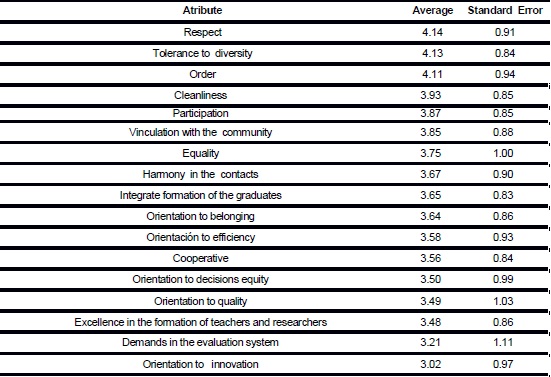
Sourse: Own elaboration.
Table 6. Degree of presence of atributes in the Faculty. Statistics descriptive for the backing up personnel
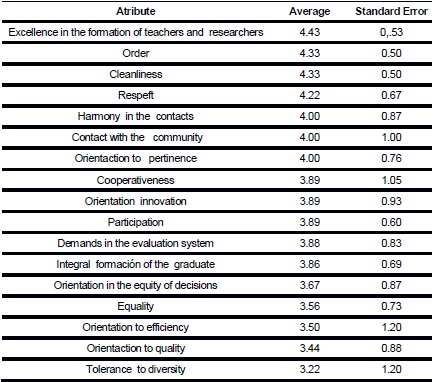
Sourse: Own elaboration
From the analysis of the preceding tables it is highlighted that the harmony in the links, the connection with the community (through the functions of Extension and Transfer, as well as through Volunteer Projects), the order / rationality and the participation seem to be perceived with greater degree of presence in the Faculty. On the other hand, the orientation to quality, the requirement in the evaluation system and the orientation to equity in decision-making seem to be seen as the less present attributes. One aspect to highlight, is that the attribute "excellence in the formation of the body of teachers and researchers" was perceived as a central feature of the Faculty, from the perspective of the support staff (arithmetic mean = 4.43, standard error = 0.53), not like that of the teachers surveyed (arithmetic mean = 3.48, standard error = 0.86).
In the table given to the interviewees in question 5, the participants were also asked to compare the degree of similarity of the Faculty of Economic Sciences with other Faculties of the University, Institutes of Higher Non-University Education and other local management universities, private In the vast majority of cases, the subjects stated that they did not know enough about these contexts to venture to make a comparison, reaching non-response rates of values higher than 80% for both groups. More enriching results were obtained from the focus groups.
When the participants were asked to reflect on factors that differentiate the Faculty from other academic units, the following emerged: (a) teacher commitment (F1, P3: "when there is unemployment in the rest, Economics gives class ... "; F2, P5:" I think that class is given not to be against, class is given for the commitment to comply with the agenda ... "; F1, P11:" I think that none of us would go through the mind that for example, a call to the end was lost, in other academic units such as psychology "we are on strike ... well the August call is not '... that does not come to mind for us"), (b) the commitment of the university staff (F1, P7: "the issue of commitment is not only in the teachers, but also the non-teaching body of this Faculty is very different from any non-teaching body of other Faculties"; F2, P8: "there is a lot of belonging and a care ... I work ... in several Faculties and the truth that The degree of institutionalism that exists here is different and the human quality of the administrative body ... I rescue those particularities that make us differentiate ourselves from the rest "; (c) issues that have to do with order, manifested in the physical conditions of work (e.g., cleaning and equipment in bathrooms, the state of the building and classrooms at a general level); (d) the type of subjects incorporated into the curricula (F1, P7: "I would say that our University has three profiles: a soft one that would be Psychology, Humanities and Health Sciences, a hard profile that would be Engineering, Exact and Agrarian, and an intermediate profile that would be Economics, Law and Architecture ... resembles Law by the way of structuring the content and the type of content ").
Regarding Private Universities, in both teacher dynamics, the incorporation of some participants who work or have worked in some (private) University (s) was sought. Although several agree that, more and more frequently, teachers of National Universities also work in private universities, there was a relative level of consensus regarding the following propositions:
(a) The contents addressed in both are similar.
(b) In private universities, teaching mobility is faster and it is made effective through less transparent mechanisms of selection (F2, P3: "The one who is Assistant here is Holder in private schools in Mar del Plata [...] without Contest" )
(c) Careers in private Universities have a shorter duration.
(d) The level of demand in National Universities would be greater than that verified in local private Universities (F1, P6: "I believe that the difference between public and private universities is at ease in the DURING those 5 years ... really I have seen that a Recuperation is the same as a Partial one, and that I have seen it in the private university ... it depends on the chair ... "; F1, P4:" no private of Mar del Plata seemed to me of high level "; F2, P9 : "If you went wrong here you would go to a private one").
(e) Private Universities offer a faster connection between the university graduate and the labor market (e.g., under agreements).
(f) There is a better regional positioning of the graduate of a National University compared to the graduate of a local private University.
(g) The graduate of a National University has the possibility of a greater disciplinary connection, through the Research activity (F2, P7 : "The professional father knows that there is research").
Finally, with regard to the Institutes of Higher Education, the following emerge as significant and differential issues of the University: the duration of the careers, the profile of the student and their needs (to acquire technical skills in the short term), the contents and the level of demand in the promotion.
2. Organizational Culture
Myths
The experience shared by members in the workplace over the years gives rise to the emergence of stories that, if they acquire the appropriate symbolic status, can be configured into true organizational myths. Regardless of their true nature or not, these stories assume a key role in the socialization of new members (Schein, 1984).
It is emphasized that the participants first recalled questions that have to do with the geographical location of the Faculty (e.g. the change of location of its first headquarters) and with the architectural features exhibited by the current university campus building. The context of creation of the Faculty was also mentioned, making the participants a reference to the last military dictatorship in Argentina, which began in 1976, when "many teachers and students were persecuted, harming their work and development" (F1, P7) . Linked to the above, the return to Democracy is remembered with joy and, together with it, the recovery of university autonomy, materialized in the democratic election of the authorities and in the freedom of teachers in planning and coordinating their Chairs. Other events were more linked to strategic decisions taken by the University, such as: (a) the merger of the Faculties of Economic and Tourism Sciences, giving rise to the current Faculty of Economic and Social Sciences, by Ordinance of the Superior Council number 113 of 1978; (b) the change of status from the Provincial University of Mar del Plata to the National University; (c) the substantive modifications made to the study plans from 1976 to 1993 and from 1993 to 2005; (d) the approval of the unrestricted admission modality to all the Faculties of the University in 2014; (e) the creation of the Virtual Campus and the digitalization of the Print Center; (f) the emergence of the group of students with disabilities at the University level; (g) the modifications introduced to the system of teaching career (by Ordinance of the Superior Council 690 and its modifications). Other remembered events were linked to changes and challenges in the distribution of power, such as the greater participation of the student faculty in the decision making process of University and Faculty Conduct.
In turn, it is observed that the previous elements (both the from more recent to older events) emerged strongly in the discourses of both teachers and support staff members, of all ages, but with a difference. In the case of the participants with greater seniority within the organization, it is observed that many of them were witnessed, while in the case of those with more recent incorporation, its transmission through socialization between co-workers and the co-worker was key. reading of documentary sources.
Heroes
In the myths usually appear prominent characters called heroes (Deal and Kennedy, 1982). Heroes are part of the organizational culture insofar as they are representative of group values or organizationally desirable and, as such, have a great capacity to influence the rest of the members. Both in the focus groups and in the surveys the participants were asked to remind someone that they consider that they have been representative of any of the values stated.
Table 7 shows the main heroes identified by the participants and the values that they represent. with greater salience they have been associated. All of them are remembered for their defense to different principles considered essential and organizationally desirable within the cultural system.
Table 7. Cultural heroes and main embodied values
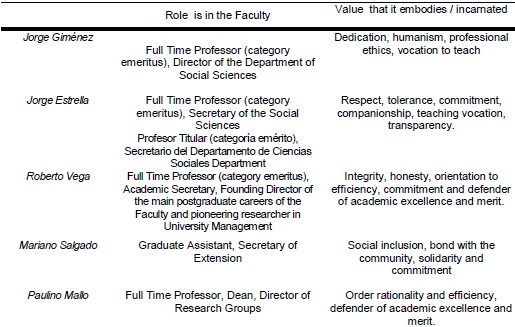
Sourse: Own elaboration
Rituals and ceremonies
Often, organizations celebrate events with the purpose of transmitting and / or reinforcing central elements of the cultural system and, therefore, contribute to its perpetuity. These have been qualified by the participants as critical events that have marked the history of the Faculty. The two main ones that are remembered are: (a) the placement of a plaque in the Postgraduate Secretariat in honor of Dr. Roberto Vega (remember that he was described as a hero who embodies the value of merit and academic quality); (b) the placement of a plaque in one of the classrooms in honor of Dr. Jorge Giménez (described as a hero who embodies the passion for teaching and the teaching vocation); (c) the celebration of a ceremony in memory of the death of Drs. Jorge Estrella and Jorge Giménez.
Values and patterns of basic assumptions
In terms of Schein (1984), behind the artifacts and symbols (Hatch, 1993) lie a set of values and assumptions that guide the behavior of individuals within the organization. Thus, several of the attributes previously identified as features of the Faculty's identity make up, in turn, a harder core part of the cultural system of the same (the cultural essence). Among them stand out: equality, respect, tolerance to diversity, participation, openness to dialogue, bonding with the community, order, autonomy and gratuity. It does not include others that have observed a lower level of consensus, such as: inclusion, orientation to quality, orientation to innovation and orientation towards efficiency. As mentioned in a timely manner, the previous ones seem to be considered by the participants as organizationally desirable values with little materialization in practice.
As has been established in previous sections, the organizational culture plays a fundamental role in shaping the perception of the members in such a way as to exhibit a certain level of congruence. However, the foregoing does not mean supposing the existence of a degree of absolute convergence. In effect, the organizational culture can be more or less shared, making possible the existence of stronger or weaker cultures (with a greater or lesser presence of subcultures) (Schein, 1985) and of dominant or opposing cultural patterns (counter-cultures). As a result, the prevailing values and principles in the cultural system may not be shared to the same extent by all members or all social subgroups.
The existence of internal contradictions (Ribes Pons, 1997) is a key factor in the propensity for change of a particular cultural system and usually materializes in the intention of certain actors to carry out actions that, subsequently, have instituting force (Pujol Cols and Foutel, in evaluation). For this reason, in question 6, interviewees were asked to list a set of principles that they understand that guide (dominate) the behavior of the organization but that they do not share.
Here highly variable responses were obtained according to the group. In the case of teachers, the following arose: (a) the lack of connection between the Chairs ("the contents are not reviewed and they are repeated in correlative subjects"); (b) inequality in the distribution and allocation of resources (using terms such as "corporatism", "favoritism" and "cronyism over academic merit"); (c) the tendency to concentrate power spaces; (d) the academic rigidity associated with the lack of innovation in pedagogical matters ("excellence is achieved by having students study by heart, a lot of bibliography and achieving degrees of analysis that neither teachers have"); (e) the trend towards academic flexibility ("there are fewer academic requirements for students in the 2005 plan", "much easier", "there are multiple instances of approval", "there is an orientation to the quantity and not to the quality of the students "," An unrestricted income was made without an adequate course that is truly equalizing of opportunities for those who do not have the adequate previous training to face successfully the university studies "), (f) the loss of power on the part of the teachers in the decision-making and an increase in student participation ("students are the competence of teachers"). Finally, in the case of support staff, there were: (a) excessive bureaucracy, (b) resistance to change, and (c) a tendency to devalue the importance of support personnel within the organization.
Some of the elements listed in the previous paragraph (related to question 6) could help explain the divergences observed for some principles analyzed so far, such as the orientation to quality.
As has been suggested, the cultural components of an organization are in continuous movement and are the result of a yes synthesis of antagonisms. However, and as has also been emphasized, it is expected that values tend to possess a certain stability within the cultural system (more so the patterns of basic presumptions). Thus, interviewees were asked to list at least three principles that, in their opinion, have remained more invariant over time (question 10) and three that have faced greater changes (question 11). The results of the salience and centrality analysis are presented in Tables 8 and 9.
Table 8. Most invariant aspects through time
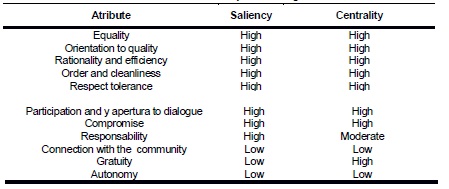
Sourse: Own elaboration.
Table 9. Most invariant aspects through time

Sourse: Own elaboration.
After having gathered spontaneous evidence, the respondents were given a list of attributes (item P12) to which they should indicate a degree of permanence perceived over time, using a scale of 1 (the attribute has varied enormously through the time) to 5 (the attribute has been invariant through time). The results, for both groups of participants, are presented in Tables 10 and 11
Table 10. Degree of permanence. Descriptive statistics for teachers
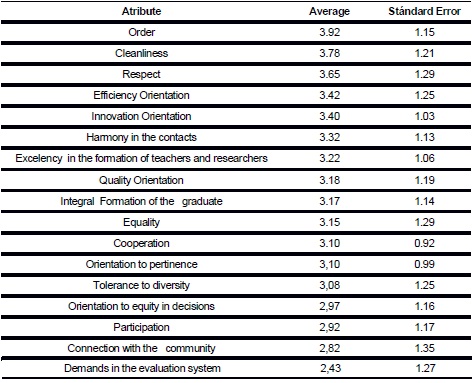
Sourse: Own elaboration
Table 11. Permanence Degree. Descriptive Statistics for back up personnel
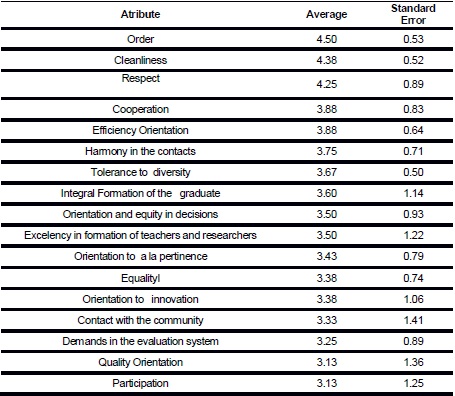
Sourse: Own elaboration
From the analysis of Tables 8, 9, 10 and 11 it is observed that the values perceived as more stable over time are: order and rationality, respect, orientation to efficiency, harmony in the links and gratuity. The values perceived with the lowest degree of permanence are: participation, equality, orientation towards innovation, orientation towards relevance, excellence in the formation of the body of teachers and researchers, the integral formation of the graduate, the link with the community and the requirement in the evaluation system. Again, there are notable divergences regarding the orientation to quality, registering this concept high levels of salience and centrality but, at the same time, low scores in the permanence scale, which suggests that it is a highly changing value through time.
3. Organizational Image
In question 14, both groups of participants were asked to indicate the agents that they consider to be key for the development of the activities of the Faculty. Both teachers and university staff seem to agree that the State is the main one. Lower level of congruence is observed for the rest of the positions. In the case of teachers, the business community and the Professional Associations / Associations occupy the next level of relevance. For the support staff, the next level would be occupied by the local community and the scientific community.
Finally, in question 15, respondents were asked to indicate their perception of the general image and attributes (quality of teachers and researchers, student competencies, quality of graduates, quality of research products, links with the community) that a set of external agents (the market, the community, the Academy, the State, and other educational institutions) possess of the Faculty. Both teachers and support staff agreed that the image they have in the media is positive, registering the highest for other educational institutions and the lowest for the State (see Tables 12 and 13).
Table 12. Organizational image. Descriptive Statistics for teachers (standard errors in parentheses)
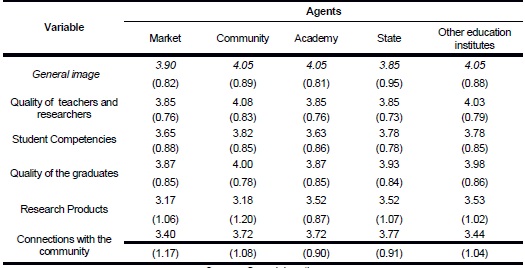
Sourse: Own elaboration
Table 13.Organizational Image . Descriptive Statistics for back up personnel. (Standard errors between brackets)
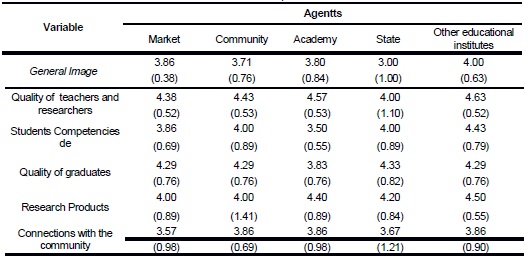
Sourse: Own elaboration
CONCLUSION
In this article a diagnosis was made of the culture, identity and organizational image of a Faculty belonging to an Argentine Public University, built on the basis of quantitative and qualitative evidence, surveyed through surveys and focus groups in which both Teachers and support staff members.
Regarding the organizational identity, this study showed that the harmony in the links, the connection with the community (through the functions of Extension and Transfer, as well as through Volunteer Projects), the order / rationality and the participation seem to be perceived from the perspective of both groups of workers as the most salient attributes of the Faculty. On the other hand, it was also mentioned that the orientation to quality, the requirement in the evaluation system and the orientation to equity in decision-making seem to be seen as the least present attributes. Regarding the orientation to quality, it was observed that the Faculty seems to be adopting a more flexible and content attitude in its relationship with the students, which has materialized in concrete decisions, such as the decrease of the approval requirements, the increase in the number of evaluation instances and the elimination of the restrictive modalities of admission, situation that has impacted on the internal perception of quality of the system.
With regard to the second of the phenomena of interest, the organizational culture, it was possible to analyze its most salient artifacts as well as to trace the more tacit elements that make up its essence. Among the first, cases of myths, ceremonies and cultural heroes were identified. Within the second group, it was observed that several of the attributes previously identified as features of the Faculty's identity, in turn, are part of the hardest core of the Faculty's cultural system, highlighting among them equality, respect, tolerance for diversity, participation, openness to dialogue, connection with the community, order, autonomy and gratuity. Other elements of a more mutable nature such as inclusion, orientation to quality, orientation to innovation and orientation towards efficiency were not included as components of the organizational culture. In effect, the previous ones seem to be considered by the participants as organizationally desirable values with little materialization in practice.
Finally, it was inquired into the perception that the workers of the Faculty have their external image. There seemed to be a shared vision among teachers and support staff in which the State, as the main source of funding for the Faculty, is its main agent of interest. The second place differed for both groups of participants, assigning teachers a predominant place to the business community (the market) and the support staff of the scientific community. Both teachers and support staff agreed that the image that the Faculty has in the environment is positive, registering the highest for other educational institutions and the lowest for the State.
To conclude this section, the authors wish to highlight the need for university managers to have a deep understanding of the organizational culture, fundamentally by configuring themselves as a strong conditioning factor during decision-making at all levels. In effect, by providing members with a socially shared and unconscious frame of reference that guides them in their way of perceiving, interpreting and reacting to the events that occur in the organization, it also strongly influences the individual, group and organizational rationality that underlies when thinking about alternatives and their restrictions (possible); proceed with its evaluation; define which aspects should be prioritized (what is desirable) and which should be avoided (the prohibited); consider which actors should be part of the process; etc. In turn, it reiterates the need to understand culture in its interaction with two other phenomena that, by definition, are part of the same system of meaning: identity and organizational image.
BIBLIOGRAPHCIAL ABSTRACT
Please refer to articles Spanish Biographical abstract.
Notes
1. Sensemaking refers to an activity by which subjects use their cognitive structures to perceive situations and interpret such perceptions (Seiler, 1973).
3.The term personal support is used to refer to the group of participants devoted to the performance of functions that provide support to the flow of substantive activities of the University, such as Teaching, Research and Extension and Technology Transfer. Within these it is possible to find: personnel of maestranza, administrative personnel, personnel of technical support, among others.
4. A mixed approach is understood to be that type of design that combines the simultaneous or sequential use of quantitative and qualitative survey strategies.
5. The focus group is a technique usually used in qualitative design research, mainly in exploratory instances, given its high potential to allow the spontaneous emergence of categories of analysis as a result of the interactions between the participants (Pujol Cols and Foutel, in evaluation)
6. A total of 415 teachers with active positions and 24 support staff are estimated (Informe de Autoevaluación Institucional)
REFERENCES
Please refer to articles in Spanish Bibliography.